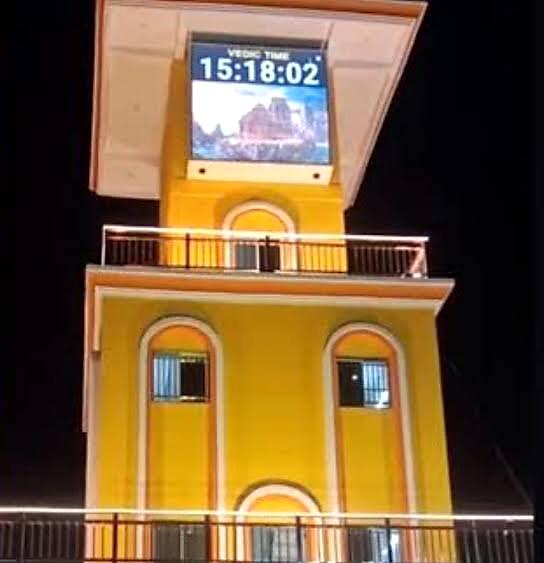
views
How many hours are there in a day? 24, you would say. And you would be right. But former merchant navy officer Aroh Srivastava would say 30. And he’d be right too.
Aroh Srivastava, who hails from Lucknow and is famous as UP’s timekeeper, has invented a unique clock which functions on the ancient or Vedic timekeeping system of 30 hours a day instead. Srivastava’s one-of-its-kind 30-hour clock took almost six years and 21 attempts to make. The clock now sits atop an 85-feet-high clock tower virtually inaugurated by Prime Minister Narendra Modi at the Jantar Mantar in Madhya Pradesh’s Ujjain district.
Vedic Blend of Virasat and Vikas
The Prime Minister lauded the watch as the perfect amalgamation of virasat (heritage) and vikas (development). “Our government ensures that the country’s rich heritage remains intact and preserved even in the course of fast-paced development. And this Vedic clock at the clock tower in Ujjain’s Jantar Mantar is the perfect example. Ujjain used to be the centre of timekeeping, but over the years, this fact was forgotten. This clock would not only remind us of the glorious past but will also be a witness to ‘Viksit Bharat’,” said PM Modi at the inauguration on February 29.
Seeing his watch being inaugurated by PM Modi was indeed a dream come true for Aroh Srivastava, but the dream doesn’t end there. The timekeeper wants to globally popularize the Indian ancient timekeeping system of 30 hours and restore the glory of Ujjain as the hub of timekeeping.
The Greenwich Meridian
Aroh Srivastava’s time research was just a matter of chance. Born in UP’s Meerut district, Srivastava, who completed his schooling from Lucknow, said it was in 2014 that inspiration struck him while studying time keeping as part of a merchant navy course in England.
“Out of curiosity, I then went to see Greenwich Meridian, a prime meridian. And there, I found out that the north-south line, selected as zero reference line for astronomical observations, was a chosen point which could be anywhere. It was chosen because by then the US had already chosen Greenwich as the basis for its own national time zone system. Secondly, in the late 19th century, 72% of the world’s commerce depended on sea-charts that used Greenwich as the Prime Meridian. Therefore, the Prime Meridian at Greenwich became the centre of world time,” said Srivastava, a former merchant navy official who left his job to carry out research on the Indian ancient timekeeping system.

This was the first instance, Srivastava said, that made him curious to dive into the depth of the existing time system. His curiosity was further fuelled while sailing during his merchant navy days. “There was an instance when we intersected Prime Meridian twice in a day and our day was recorded as 26 hours. This instance made me think why only 24 hours? Why not any other number of hours in a day?”
Why 24?
“While researching, I found that in Egyptian and Babylonian culture, there used to be a 24-hour time system, and going by this, the first mechanical watch was made in France during the 15th century. I also found out about the ancient Indian time-keeping system that was based on the movement of the sun. I read about Ujjain and how it used to be the centre of timekeeping. Back then, in the 15th century, due to lack of technology it was just impossible to build a watch based on an Indian timekeeping system that showed 30 hours a day. But today, it is possible. Hence, I thought of making a watch on my own,” the 31-year-old researcher said.
He decided to quit his job and follow his dream of making a watch based on the Indian ancient-timekeeping system. “And that’s how the idea of making a 30-hour watch came to me,” said Srivastava.
Vedic Timekeeping
The 30-hour days find mention in ancient Indian scriptures, including the Rig Veda. “In ancient times, the time format used to be called ‘Muhurat’. It was calculated from one sunrise to another. As per ancient timekeeping, there were 30 hours (muhurat) between the two sunrises, which is clear enough to hint that ancient Indians calculated and kept track of a 30-hour time-format. There is a mention of the 30-hour timekeeping format in the ancient texts, including Muhurta Chintamani by Ramachandra Sharma, Brihat Parasara Hora Sastra by Maharshi Parasara and others,” he added.
How Does the Vedic Clock Work
Aroh Srivastava’s Vedic clock calculates the time using latest tech. “The day of this clock changes when the sun rises. 00:00 hours means sunrise and the date changes. The clock is based on ‘The Alternate Time Theory’ which is a modern explanation of Muhurat mentioned in Vedic texts and ancient Indian knowledge system,” he explained.
He said the clock demonstrates 30 Muhurat (hours), which is further divided into 30 kaal (minutes) and 30 kastha (seconds). And 30 Muhurat defines the time interval between two consecutive sunrises, whereas 30 kaal would be approximately 48 minutes in the existing time system and 1 kaal would be equal to 30 kastha, which amounts to 96 seconds approximately. And one kastha would be equal to 3200 milliseconds approximately.

The clock’s formulation and working, Srivastava said, has been verified by experts of the field, including the Dongla Observatory and Vikramaditya University.
The Advantages of a 30-Hour System
“No more varying time of sunrise as 00:00 hours will be the time of sunrise at every place. This is the biggest advantage,” Aroh Srivastava said.
“Secondly, it would make the working culture more systematic with respect to nature. Thirdly, billions of units of electricity could be saved every year by using Local Mean Time for regions with similar solar effects. And saving this big amount of electricity will empower the places with scarcity of electricity and will save lots of natural resources which will also control pollution caused by generation of electricity,” he said.
“And above all,” he said, “it will bring pride to the country and make the current generation and the world aware of the rich heritage of India.”
21 Attempts, 5 Years and Rs 1.05 Crore
It was not an easy feat by any means. Srivastava said that in 2017, when he embarked on the mission, he realised there is not much information available about the Indian ancient timekeeping system. Hence, he decided to go through the ancient literature to complete his research.
It took almost five years for Srivastava to complete the research and understand the Indian timekeeping system. It took almost 21 attempts and five years for him to complete his dream watch.
During his journey, he suffered a financial crunch, following which he took the help of his father. The finished watch costs around Rs 1.05 crore.
Thereafter, the challenge was to bring the watch before the world. “I wanted to highlight my work for which I took out a cycle yatra from Lucknow to Kanyakumari to promote my work,” he added.
During this journey, while passing through Madhya Pradesh, Srivastava met Dr Mohan Yadav, the Chief Minister of Madhya Pradesh, who assured all possible help and also assured the establishment of the watch in Ujjain. He also sponsored the watch.
It took almost eight months for Srivastava to complete his cycling tour. On February 29, PM Narendra Modi inaugurated the watch.
Aroh Srivastava now wants India to adopt its own ancient timekeeping system. “Through my work, I wanted to make the present and the coming generation aware of our rich culture and how ancient Indians were way ahead of others. I will continue to follow and promote our own timekeeping system till my last breath,” he said.




















Comments
0 comment